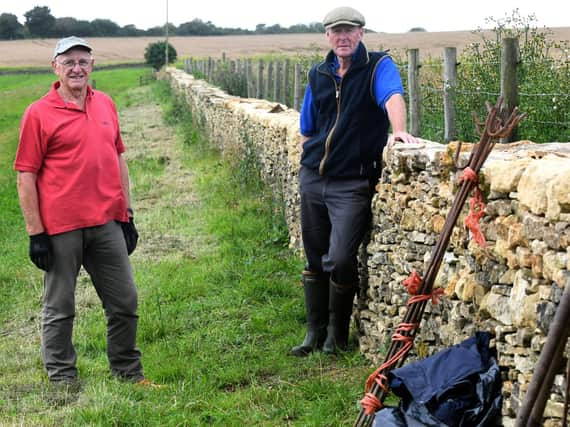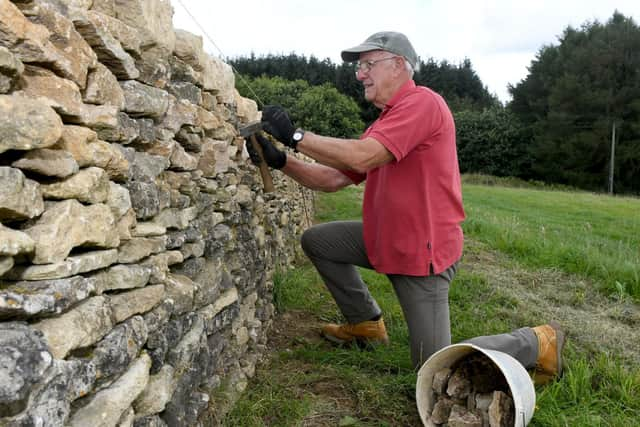Retired Merchant Navy Captain turned dry stone waller finishes a marathon 805 metre wall for fellow mountain rescue colleague


Retired Merchant Navy captain, Peter Holtby of West Ayton, has completed just that across a marathon project of 805 metres at his mountain rescue colleague, John Robinson’s High Scamridge Farm, on the edge of Dalby Forest near Ebberston.
“It’s been quite an achievement,” said Peter. “I have put it back the way it was. There was quite a lot of digging out of the original stones out of the clay on both sides of the original wall as over time they had become buried.
Advertisement
Hide AdAdvertisement
Hide Ad“That was the hardest part, but when I walked home from High Scamridge the other day and turned back it looked beautiful. I’ve thoroughly enjoyed it, even though I would not call myself an expert by any means.


“I’m glad I became a ship’s captain and not a dry stone waller.
“It’s a vernacular rural working wall and perhaps not as pretty as it could have been, but it is strong and will last.
“The reasons the previous wall went down were due to age, vegetation and also being built with a hollow centre.
Advertisement
Hide AdAdvertisement
Hide Ad“I can understand the reasons why the men built it that way 200 years ago because they were probably on some kind of piece rate, but I have worked on it in my own time, on and off for a number of years.
“Once I’d started pulling some parts of the old wall down it just crumbled because there was no packing inside it.
“In Scotland they say to keep the heart up, meaning the heart of the wall that should be packed solid with smaller stone between the outer layers, adding weight.
“Every metre of this wall has about a tonne of stone. It’s thick too. It’s more than 60 centimetres wide at its base and tapers up to between 40-50 centimetres.
Advertisement
Hide AdAdvertisement
Hide Ad“I’ve met a lot of friends while rebuilding the wall. Pebbles, one of the farm cats, used to come and see me at lunchtime because she knew I invariably had cheese sandwiches.
“The hens would come too and talk to me. I had everything from a common lizard which set itself on a stone and just watched what I was doing, to a kestrel that had caught a shrew and started eating it as though it was its breakfast.”
Peter started his secondary career in dry stone walling 25 years ago having initially joined a local conservation group at Raincliffe Woods near Scarborough. He began patching walls, rather than starting from scratch as most of John’s walling has proven to need.
The project came about when the friends met through their involvement with mountain rescue.
Advertisement
Hide AdAdvertisement
Hide Ad“Peter was the first person I met when I joined mountain rescue ten years ago,” said John. “We come from similar backgrounds as he was with the Merchant Navy and I was a Royal Marine.
“Strangely enough, we were both serving in the Falklands War at the same time. We became good friends and I found there wasn’t a lot he couldn’t do.
“That’s where the reinstatement of the dry stone walling for the farm really started.
“We initially began with the idea of about 100 metres including reinstating the farm gateway. It mushroomed from there to the 805 metres Peter has just completed.
Advertisement
Hide AdAdvertisement
Hide Ad“This was a warrener’s farm, a rabbit farm, and we have included the rabbit smoots, small holes in the wall that are meant to be no more than 20 centimetres high. We now get a lot of traffic at the base of the wall.
“Why would you go back to a dry stone wall when you can use pig wire and fence posts that is a lot cheaper?
“The fact is, a dry stone walls lasts but also offers enormous shelter for livestock. We are 650ft above sea level here and the weather can be pretty lousy at times.
“The sheep just cling to the wall when it is either too hot or too cold, in wind or rain. It’s actually quite unbelievable the amount of livestock and wildlife that is enhanced by a dry stone wall.
Advertisement
Hide AdAdvertisement
Hide Ad“I was born on a farm in Dartmoor where I would help my mother with her North Devon cattle and Dorset Horn X Scotch Halfbred sheep.
“The dry stone walls down there were made of granite. I trained on the veterinary side of agriculture, studying at Edinburgh and took a Nuffield Farming Scholarship.
“I came to Yorkshire through my military career to fly helicopters and when I came out of the Marines I worked for agricultural company Ritchey Tagg in Masham and equine companies.
“When my wife Annie and I arrived here this farm was derelict and fairly well run down.
Advertisement
Hide AdAdvertisement
Hide Ad“We’ve only 28 acres with quite a lot of forestry and around 17 acres of mowable grass, which I let for sheep from a neighbouring farmer.
“With all of the walling down, there was nothing to stop sheep going into Dalby Forest and once they’re in there you’re unlikely to see them again.”
Not all of the stone Peter has used was readily available from the previous walling, but John managed to acquire from various local sources.
“We ran out of stone. I managed to get 30 tonnes from a neighbouring farmer, Syd Pearson, who has a stone quarry.
Advertisement
Hide AdAdvertisement
Hide Ad“The Hardwicks, who grow seed potatoes, would go through quite a lot of limestone with their destoner and they would dump what came up with me, which provided more of the small packing stones Peter needed.
“I was the sifter and shifter. I also managed to get hold of a lot of wall that had been a top stone and that has managed to get us through.
“We’ve stuck to the right stone all along, limestone predominantly with some sandstone. It really does differ from place to place so it was important we acquired it from around here.
“Peter’s skills are in building. Mine are in shifting to the right place, with his dodgy wheelbarrow.”
Support The Yorkshire Post and become a subscriber today.
Advertisement
Hide AdAdvertisement
Hide AdYour subscription will help us to continue to bring quality news to the people of Yorkshire. In return, you'll see fewer ads on site, get free access to our app and receive exclusive members-only offers.
So, please - if you can - pay for our work. Just £5 per month is the starting point. If you think that which we are trying to achieve is worth more, you can pay us what you think we are worth. By doing so, you will be investing in something that is becoming increasingly rare. Independent journalism that cares less about right and left and more about right and wrong. Journalism you can trust.
Thank you
James Mitchinson
Comment Guidelines
National World encourages reader discussion on our stories. User feedback, insights and back-and-forth exchanges add a rich layer of context to reporting. Please review our Community Guidelines before commenting.